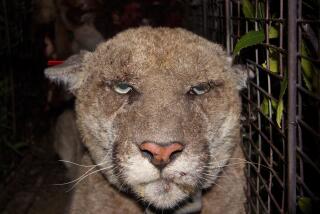Acquisition of Ranch Called Important for Wildlife
Runkle Ranch, a rugged 4,400-acre expanse of hidden canyons, jutting rock formations and shady meadows in the Santa Susana Mountains northwest of the city of Los Angeles, is the centerpiece of lands acquired by a state agency this month in a complicated property swap with entertainer Bob Hope.
Acquisition of the ranch is viewed by some wildlife experts as a major step toward safeguarding a 35-mile wildlife corridor from the Santa Susanas to the Santa Monicas and the sea. The property is home to bobcats, mountain lions and predatory birds that sweep down from sandstone pinnacles. Although less accessible to hikers than popular areas of the Santa Monicas, the ranch offers dramatic valley views and includes oak-studded meadows within a dayâs walk.
The swap that allowed the Santa Monica Mountains Conservancy to acquire the ranch and other lands is not without its critics. Some parklands advocates fear that the dealâs linchpin--a trade of 59 acres of federal parklands in Cheeseboro Canyon in western Los Angeles County to a developer--sets a dangerous precedent and would destroy another valuable wildlife habitat. This part of the deal still needs National Park Service approval.
But because it enhances the corridor, some wildlife experts remain enthusiastic about the deal.
âIt provides linkages between entire mountainous regions that have not been able to be linked and in fact are becoming isolated islands in a sea of development,â said Michael Soule, a UC Santa Cruz professor and a specialist in the ecology of wildlife corridors. âThis is the last chance. If this deal doesnât go through, it really is the death knell for any link between the Santa Monica Mountains and the mountainous areas to the north.â
Paul Edelman, an ecologist who works with the Santa Monica Mountains Conservancy, is studying the wildlife corridor, which has grown increasingly important, and tenuous, as development in Los Angeles County moves relentlessly west into Ventura County.
Last week, as he does every week, he noted the tracks of animals who had funneled through one of the narrowest points of the corridor--a tunnel beneath the Simi Valley Freeway on the south flank of Runkle Ranch.
âThis looks like a raccoon right here,â he said, pointing to a tiny hand-like print. âHereâs a bobcat.â
Without Runkle Ranch in public ownership, said Edelman and Soule, the corridor would be threatened, and so would the long-term survival of the bobcats, raccoons and other wildlife that need room to migrate to maintain healthy, growing populations free of the problems caused when species inbreed.
The ranch is the most significant part of 5,700 acres acquired from Hope this month for $20 million. In addition to its importance for preserving the wildlife corridor, the conservancy also points to the ranchâs natural beauty, which can be seen in a diverse blend of landforms ranging from rocky peaks to flat, grass-covered meadows.
âIn a half-day hike, youâre looking at seeing fossils and a picnic under an oak stand,â said Joseph T. Edmiston, director of the conservancy. âYouâre looking at spectacular rock formations, to say nothing of views over both the San Fernando and Simi valleys.â
But critics are not mollified because of the proposed Cheeseboro Canyon swap. The developer, Potomac Investment Associates, needs the canyon parklands to build an access road to the 750 homes and golf course it wants to build on nearby Jordan Ranch in eastern Ventura County, which is also owned by Hope. If the land swap is not approved by the National Park Service, Runkle Ranch and the rest of the 5,700 acres would revert to ownership by Hope.
âBob Hopeâs road to riches will destroy a critical wildlife habitat,â said Mary Wiesbrock, an Agoura Hills activist who has called for Edmistonâs ouster over the land swap. But she concedes that Runkle Ranch is worth saving.
The ranch includes Blind Canyon, which Los Angeles County sanitation officials have considered as a possible landfill site. The precipitous depth that gives Blind Canyon its beauty also makes it suitable for use as a garbage dump.
South of Blind Canyon, a hiker may traverse a rugged part of Runkle Ranch where charred, chest-high chaparral frames sandstone rock formations that jut into the sky. Some are topped with bird droppings, indicating that predatory birds such as hawks use the rocks as hunting perches.
At night, mountain lions and bobcats come out to hunt, although a person would be unlikely to encounter the shy predators, Edelman said.
Elsewhere on the ranch is a mountainside mosaic of seashell fossils. The fossils are so plentiful that the conservancy is restricting the area to supervised tours only, so they are not removed, Edmiston said.
At the northernmost reaches of Runkle Ranch, rocks and mountainsides give way to flat, grassy meadows leading eventually to the placid shade of Las Llajas Canyon, dense with oak, sycamore and cottonwood trees.
But the value of the lands as a wildlife habitat depends on the animalsâ ability to move freely in and out, using paths such as the tunnel beneath the Simi Valley Freeway. If isolated or confined to one area, animal species may die out for a lack of genetic diversity because, in time, they begin mating with their cousins and become vulnerable to diseases and other inherited maladies, Edelman said.
Kent Livezey, a Nature Conservancy ecologist who has studied the wildlife corridor in the Santa Susana and Santa Monica mountains, agreed that Runkle Ranch is important but warned that Jordan Ranch and Cheeseboro Canyon also are part of a significant wildlife habitat.
âThe Runkle Ranch should be a real help to the corridor, but that does not mean we can chop off a whole hunkâ of Cheeseboro Canyon, Livezey said.
More to Read
Sign up for Essential California
The most important California stories and recommendations in your inbox every morning.
You may occasionally receive promotional content from the Los Angeles Times.










